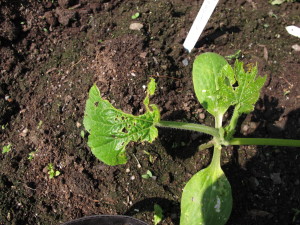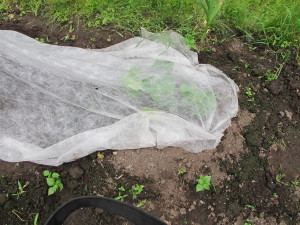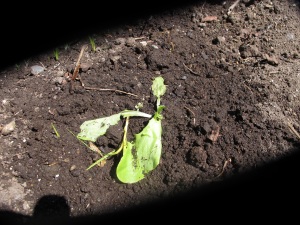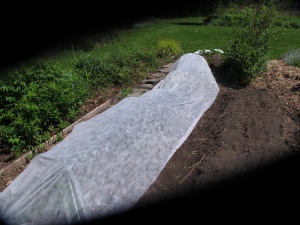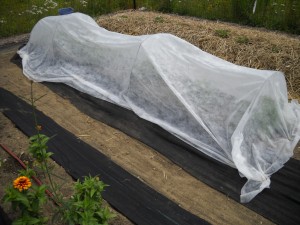Dealing with Pests and Diseases
I understand why many gardeners shop on Death Row. That’s what I call the pesticide aisle at the garden center. Insecticides, fungicides, herbicides are sold in cheerful colorful bags, often with pictures of blooming flowers on the bag. I don’t shop there and try to avoid even walking down the aisle because the smell of death – poison – is often in the air.
Gardeners shop on Death Row because something is threatening their roses or their broccoli. Flea beetles making holes in the cabbage? Nuke ‘em. Japanese beetles? Gotta kill ‘em. I get the urge, too. But there are alternatives.
Let’s start with something easy: I drape a light-weight gauzy film of agricultural fabric over plants to keep bugs from physically getting to my plants. This cloth allows sun and rain to pass through, but not bugs. It’s called row cover or by trade names like Reemay and Agribon. There are other brand names, too.
Row cover comes in different weights, and some heavier types can be used to keep in a little heat at night, holding off frost. But its best use is to keep plants bug-free. I use it over my vine crops like cucumbers and squash as they are very vulnerable to a pest called the striped cucumber beetle.
Row cover is not perfect: striped cucumber beetles live in the soil, and sometimes will appear under the row cover, but mostly it prevents them from getting to the plants. To be on the safe side, I start cukes and squash inside the house 3 weeks or more before planting time (or buy a 6-pack of starts). That gives me good-sized plants that can survive some beetle attack.
Generally I just drape the row cover over the cucumber plants and pin down the edges with special staples sold for the purpose. It is light enough that it will just float on top. But since vine crops are insect pollinated, I need to take it off once the plants start to bloom.
Hoops are sold to support row cover, too. Five foot sections of #10 wire are sold for the purpose. Just poke one end into the soil, bend it, and poke in the other end. This is great for keeping flea beetles and cabbage moths of broccoli, cabbage and related plants.
Repellents can help to keep insects off plants. Liquid fish fertilizer has worked for me to reduce the number of Japanese beetles on roses and other decorative plants, though I wouldn’t use it on vegetables. Garlic Barrier is product made from garlic and citric acid that can be diluted and spread on plants to repel insects. It is rated for use on vegetables, and has no flavor once it has dried. In any case, you must get the repellents sprayed before the insects show up, and need to re-apply regularly. It is fine for use by organic gardeners.
Traps sound good, but generally are not. Japanese beetle traps use a sex hormone to attract the beetles, but unfortunately they attract many more beetles than they catch. And those pesky beetles like to have a snack before investigating the scent of sex. Give them to your neighbors, perhaps, but don’t use them!
Hand-picking bugs really does work, particularly if you are diligent when they first appear. Pick potato beetles every day as soon as you see them (or their larvae). Look under the leaves for orange egg masses, too. Don’t let a second generation get started! Get them early, and avoid trouble later on.
Keep these points in mind if you want have a good garden and healthy plants:
1) Healthy plants growing in favorable conditions (such as the right amount of sun, and moisture in the soil) are less susceptible to diseases.
2) Select disease-resistant cultivars when possible. Modern hybrids are often bred for disease resistance.
3) Don’t over-fertilize. Too much nitrogen gives fast green growth, but promotes weak tissue that is more susceptible to diseases.
4) Try to keep leaves dry when watering. Moisture on leaves, particularly at night, helps some fungal diseases to get established. A hand-held watering wand can direct water to the roots; overhead sprinklers get everything wet.
5) Prune off diseased leaves and dispose of them in the trash. Never let diseased plants over-winter in the garden. Keep your garden clean. Clean up in fall and spring to remove diseased plant matter.
6) Lastly, don’t overreact. Most fungal diseases won’t kill a healthy plant that is well planted in good soil. Don’t rush to spray chemicals. Once a leaf is infected, you can’t fix it, only live with it or cut it off.
As an organic gardener I accept that sometimes bugs or diseases win. I no longer grow Oriental or Asiatic lilies because of a beautiful red beetle that attacks them. I can’t control the pest by hand picking. That’s okay, I grow angel’s trumpet (Datura spp.), a lily-like flower that is even better – it blooms for many weeks with gorgeous big white flowers). And it doesn’t need chemical poisons to thrive.
Read my blog twice weekly at www.dailyUV.com. You can sign up to get the blog post sent to you be email.
Season Blues
Thank heavens we finally got some rain. I had less than half an inch in the first 29 days of May. If my plants were puppies, they’d have done a lot of whimpering during that last hot week of the month. They’d have been begging for water, complaining of neglect. There are things we can do to help our plants through hot spells, and it makes sense to think about them now, as summer begins.
Just as EMT’s do at an accident scene, sometimes it’s necessary to perform triage in the garden. Pick the plant that is suffering the most and water it. In principle, I don’t believe that established perennials should need to be watered. Put the right plant in the right place and it should thrive. But after a month without rain, watering may be needed and if you have lots of plants, you need to decide where to begin.
I begin with newly planted things that are stressed. These are the ones that have limp leaves, or, worse yet, are flopping over. The very act of planting disturbs roots and the fine root hairs that suck up water from the earth. If you move a perennial or small tree, you have certainly cut off some of the roots – they extend long distances and you cannot see the finest of their roots. Even a shrub purchased at a nursery and carefully planted will take weeks to settle in. Some shrubs even need extra water in year two after planting. And roses do best with more water than most.
How you water is important, too. I don’t water with an overhead sprinkler. They water everything, including walkways and weeds. I use a handheld device called a watering wand that allows me to get water where I want it – at ground level. The 36-inch wand attaches to the hose and has a nice “rose” on the end that turns a potentially torrential deluge into a strong but gentle shower. There are lots of brands, but I find that “Dramm” brand devices work perfectly every time – and are worth the extra cost. I have a thumb switch on the wand that allows me to turn it off and on, and to regulate the flow.
My lettuce, started indoors by seed and hardened off well, wilted badly after planting last week. I planted at dusk and watered it well, but the next day hit 90 degrees. When I saw it gasping for breath at noon, I gave it a dose of a commercial remedy I use for transplant shock. It is called SuperThrive (all one word) and is made from seaweed extract and plant hormones. A capful in a watering can is all it takes, and it does help.
If you’ve just planted veggies that are suffering from the heat and dryness, think about providing some shade. I covered my lettuce with row cover (also called by trademarked names, Reemay or Agribon). I have wire hoops that I pushed into the soil, then draped this thin layer of synthetic fabric over the hoops and pinned down the edges with landscape staples. It protects the plants from hot, drying winds and reduces the intensity of the sunshine slightly. Air and moisture passes through this fabric, which I also use at times to keep insects off plants.
I also planted a small clematis vine last week, and provided some temporary sun protection simply by simply placing a couple of buckets near it to provide shade in the hottest part of the afternoon. Later I will plant a medium-height flower in front of the clematis to keep the roots shaded and cool, which they like. I’ve been known to use sheets of cardboard to provide shade, or to use a beach umbrella at planting time.
Soils make a big difference in watering needs. Sandy soils dry out and drain fast. Good loam holds moisture nicely. Clay soils can hold too much water, rotting roots in wet times. Adding compost to any soil at planting times helps to achieve that desired “moist, well-drained soil” that gardening articles suggest.
Mulch is good for holding in moisture and discouraging weeds. In the vegetable garden I put down newspaper (4 to 6 sheets thick) covered with straw, hay or leaves. Around bigger plants like tomatoes I leave some open, un-mulched space around the stem. That allows a quick rain or a visit with my watering wand to get moisture to the roots more easily.
In flower gardens I sometimes use finely ground hemlock bark that I buy by the pickup-truck load. Some gardeners like to install landscape fabric under the mulch, but I rarely do that. I find that the worst of the weeds can get through anyway, and their roots become entangled with the fabric, making it tough to remove them entirely.
Chopped autumn leaves are great mulch for gardens. They help to keep down weeds, provide organic matter to soil microorganisms, and hold in moisture. Earthworms love leaves. One gardening friend bags all her leaves after running over them with a lawnmower in September, and stores them for use now.
Weeds, well known garden villains, are not just competing with your onions and lettuce for sun and soil nutrients, they also want the water – especially in dry times. Get your garden off to a good early start this summer by weeding for 15 minutes a day – minimum. I have a lot of garden space and try to spend an hour a day pulling weeds. Once weeds bloom and spread their seeds, the work will multiply exponentially, so do it now and have less work later.
Henry Homeyer is gardening educator and author of 4 gardening books. His website is www.Gardening-Guy.com. You may e-mail questions or comments at henry.homeyer@comcast.net.
Vegetable Gardening
I planted much of my vegetable garden early this year. Living in a cold spot, I usually wait until June 10 to plant frost and cold-sensitive plants. But lured by perfect warm weather I planted most of my tomatoes on Memorial Day weekend. The soil was 60 degrees and sun strong. Then the weather turned chilly and wet. My tomatoes will survive this, and I can always cover them if there is threat of frost. Still, after all these decades, I should have more patience. Tomatoes, peppers, eggplants, cukes, squash: all these like hot weather.
I did not plant my vine crops early, however. I like to start cukes, squash and pumpkins indoors in May in 4-inch pots, growing them under lights until they have vines a foot long with several leaves. Or sometimes I will buy a few nice big plants. I do this because of the dreaded striped cucumber beetle, a pest that can – and will – eat up a plant’s first 2 leaves in one night. But a bigger plant can survive a few beetle bites without trouble.
Another way to minimize beetle damage on any crop is to cover it with row cover, also called Reemay or Agribon (both are trade names). Row cover is a thin woven fabric that breathes and allows more than 90% of the sun’s light to pass through – without burning your plants the way clear plastic would. Got trouble with little green caterpillars on your broccoli? Cover it up. Rain will pass through it, too.
Although you can just lay row cover on your plants, I like to stretch it over wire hoops that are sold for the purpose. It gives the plants room to grow. In either case, you must seal the edges or some critters will crawl under for a free lunch. You can use earth staples sold for the purpose, or just use those stones that Mother Nature pushes up out of the soil every winter.
Row cover holds in some heat, which is good at this time of year. But if you need insect pollination – all the vine crops need it – you must take off the covers when they flower or hand pollinate, which is time consuming. I sometimes leave row cover on eggplants all summer as they are wind pollinated.
Thinning plants started outdoors by seed must be the most tedious of all garden tasks. Carrots, lettuce, rutabagas, beets? All need to be thinned for best results. Beets and carrot babies are good to eat if you wait until the end of the month of June. I try to have them thinned to one inch apart by the Fourth of July, with a wider spacing a month later.
Beet greens are a classic early summer dish that I like served with a sprinkling of gourmet rice wine vinegar instead of the calorie-packing butter that I use on my asparagus. And just a reminder, don’t keep picking asparagus for more than 3 weeks. Oh, it’s tempting to keep picking the spears that pop up to replace those you’ve eaten. But the greens are needed to feed the roots, and picking for too long will cause the patch to run down.
My asparagus patch produced well this year, its third, and I am rewarding it with regular weeding, a light top-dressing of organic fertilizer and a little compost. Then I will cover the compost with a layer of wood chips to minimize the need for weeding later on this summer.
Last fall I covered up my wide raised (mounded) vegetable garden beds with hay, straw or fallen leaves after cleaning out most of the weeds. This really minimized my work this spring. I pushed off the winter cover of mulch into the walkways in early May, which kept weeds from starting up there. The sun warmed the soil, spawning some weeds. But I pulled them out or sliced them off before they got established, and then planted without rototilling.
I know some gardeners who love their rototillers as much as they love their spouses. They do create a lovely-looking bed, and they make all the weeds “disappear”. But if you chop up witch grass or perennial weeds, each piece may well produce a new plant in a few weeks.
Many weeds have what I call ‘photo-triggers’. This means that they need some light to know it is time to wake up and grow. Buried down 4 inches, the seeds can sleep for years. Turn them up with a rototiller and they germinate. So at planting time I try to minimize how much I disturb the soil. I use an ancient 4-tined potato hoe and my CobraHead weeder (www.CobraHead.com) to do most of the soil work.
We’ve all heard of the “runner’s high” – a feeling of well being from running. Sometimes I get a “gardener’s high” instead. Planting a garden will do it for me. I just wish I got the same feeling after an afternoon of weeding – instead of a tired back.
Henry Homeyer’s Web site is www.Gardening-Guy.com. He is the author of 4 gardening books, and a children’s fantasy-adventure, Wobar and the Quest for the Magic Calumet.



